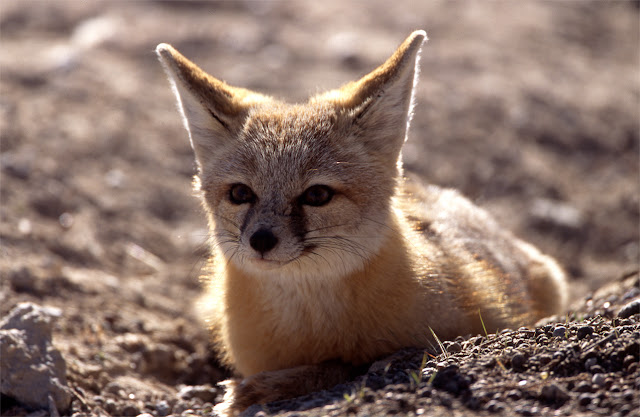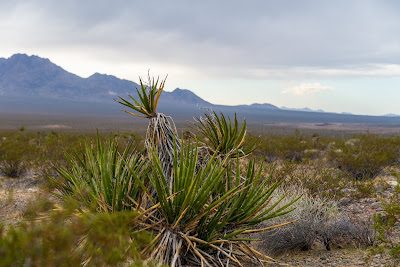Gemini Solar Project Threatens Vibrant Ecosystem
The Gemini Solar project proposed for desert wildlands next to the Valley of Fire State Park could displace or kill over 260 desert tortoises and dozens of kit foxes, American badgers and western burrowing owls, according to recently released wildlife surveys (1, 2). Climate change poses an urgent threat to these same wildlife, but it is inexcusable to bulldoze wildlands to install the same solar panels that can just as easily be installed on rooftops or already-disturbed lands. If we are destroying wildlands to reduce greenhouse gas emissions, then we are perpetuating the stunningly short-sighted sacrifice of nature to continue feeding otherwise unsustainable consumption, despite readily available options that have much lower impact on wildlife.
Wildlife Surveys Highlight Poor Location Choice for Solar Project
Biologists conducted two surveys in 2018 and 2017 and discovered that the proposed Gemini Solar project site currently hosts a diverse array of wildlife. Based on the surveys, biologists estimate that nearly 260 desert tortoises likely inhabit the proposed solar project site. Biologists also encountered 99 active desert kit fox burrows, spotted 11 burrowing owls, 29 American badger burrows, and found sign that desert bighorn sheep have used the area. All of these animals will be displaced or killed if the project is constructed. The public is awaiting additional surveys on the project's potential impact on bird and plant life. For desert tortoises that are relocated, studies have shown that they reproduce at a lower rate and may suffer from lower survival rates due to increased vulnerability to predation and exposure to the elements. Burrowing owls and kit foxes likely would be hazed until they leave the area, and it is reasonable to expect that the stresses they endure finding a new home could result in mortality.
Most desert wildlife species are already being harmed by the effects of climate change. Destroying their habitat for energy projects is only going to compound those effects and reduce the resilience of their remaining populations. Studies on endangered wildlife often emphasize that protecting remaining habitat is one of the most important steps we can take to improve their chances of survival. The most important step to combat climate change is to switch to clean energy. Balancing the two requires us to chart a smart and sustainable deployment of clean energy that does not involve wholesale destruction of pristine habitat with every solar or wind project that we build. The Gemini Solar project is a poster child of what not to do.
Rooftop Solar Potential Left Untapped
The map below shows the results of the 2017 desert tortoise survey of the proposed Gemini Solar project site. The map only depicts a portion of the total project site. Green circles represent locations where live tortoises were observed.
 |
| Nearly 100 active desert kit fox burrows were recorded during surveys of the proposed Gemini Solar project site. Nearly a dozen burrowing owls were also spotted during surveys. Photo by BLM. |
Wildlife Surveys Highlight Poor Location Choice for Solar Project
Biologists conducted two surveys in 2018 and 2017 and discovered that the proposed Gemini Solar project site currently hosts a diverse array of wildlife. Based on the surveys, biologists estimate that nearly 260 desert tortoises likely inhabit the proposed solar project site. Biologists also encountered 99 active desert kit fox burrows, spotted 11 burrowing owls, 29 American badger burrows, and found sign that desert bighorn sheep have used the area. All of these animals will be displaced or killed if the project is constructed. The public is awaiting additional surveys on the project's potential impact on bird and plant life. For desert tortoises that are relocated, studies have shown that they reproduce at a lower rate and may suffer from lower survival rates due to increased vulnerability to predation and exposure to the elements. Burrowing owls and kit foxes likely would be hazed until they leave the area, and it is reasonable to expect that the stresses they endure finding a new home could result in mortality.
 |
| Burrowing Owl. Photo from USFWS. |
Most desert wildlife species are already being harmed by the effects of climate change. Destroying their habitat for energy projects is only going to compound those effects and reduce the resilience of their remaining populations. Studies on endangered wildlife often emphasize that protecting remaining habitat is one of the most important steps we can take to improve their chances of survival. The most important step to combat climate change is to switch to clean energy. Balancing the two requires us to chart a smart and sustainable deployment of clean energy that does not involve wholesale destruction of pristine habitat with every solar or wind project that we build. The Gemini Solar project is a poster child of what not to do.
 |
| Screenshot of a map from the project plan of development, showing its location northeast of Las Vegas. |
Project Would Represent Significant Extension of Industrial Zone
Several
large solar projects have already been built northeast of Las Vegas
along Interstate-15 on land that was mostly wild in character as of
2010. The Department of Interior established the Dry Lake Solar Energy
Zone as a means to confine solar
sprawl to a 9 square mile area of public lands deemed appropriate
for energy development. However, completed solar projects
already sprawl well outside of the Solar Energy Zone, and pending
projects threaten to further convert a much larger swath of desert into a de
facto industrial zone.
In addition to the Gemini Solar project, developers are planning at least four others in the area: Invenergy's project in the Solar Energy Zone, the Eagle Shadow Mountain Solar project on the Moapa River Indian Reservation, the Red Flats Solar project, and the Red Valley Lands Solar project. If all are built, much of the landscape between the northeastern edge of Las Vegas and the Muddy River would be dominated by energy projects. That is a 30 mile span nearly equal to the diameter of the urban sprawl of Vegas itself.
In addition to the Gemini Solar project, developers are planning at least four others in the area: Invenergy's project in the Solar Energy Zone, the Eagle Shadow Mountain Solar project on the Moapa River Indian Reservation, the Red Flats Solar project, and the Red Valley Lands Solar project. If all are built, much of the landscape between the northeastern edge of Las Vegas and the Muddy River would be dominated by energy projects. That is a 30 mile span nearly equal to the diameter of the urban sprawl of Vegas itself.
Rooftop Solar Potential Left Untapped
According to a National Renewable Energy Laboratory (NREL) study, Nevada's buildings have the technical potential to host 8,700 megawatts of solar generation capacity, yet Nevada is barely about to reach 80 megawatts of installed rooftop solar under its net-metering program. The state is rushing to carve up its open wildlands when it has barely leveraged the more sustainable alternative of covering rooftops with the same solar panels that energy companies want to install on desert tortoise habitat. The NREL study did not even include the potential to install solar over parking lots or pair those installations with battery storage, which would significantly boost Nevada's clean and sustainable energy portfolio.
Nevada residents should urge their elected officials to bolster incentives for distributed solar generation on rooftops and over parking lots. Nevada could expand its net-metering incentives to encourage more rooftop solar, and put in place policies that require or incentivize solar on new buildings and over parking lots.
The public can also comment on the BLM's review of the Gemini Solar project at the BLM's website.
Nevada residents should urge their elected officials to bolster incentives for distributed solar generation on rooftops and over parking lots. Nevada could expand its net-metering incentives to encourage more rooftop solar, and put in place policies that require or incentivize solar on new buildings and over parking lots.
The public can also comment on the BLM's review of the Gemini Solar project at the BLM's website.
The map below shows the results of the 2017 desert tortoise survey of the proposed Gemini Solar project site. The map only depicts a portion of the total project site. Green circles represent locations where live tortoises were observed.


Comments
Post a Comment